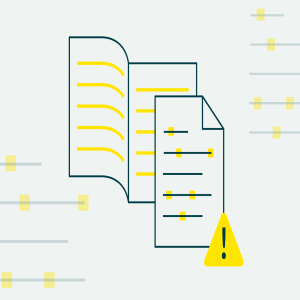In its simplest terms, ‘mosaic plagiarism’ refers to weaving phrases and text from several sources into one’s own work and adjusting sentences without quotation marks or attribution. Although an apt name for the type of misconduct it describes, it can be confusing for students to understand mosaic plagiarism as a more extensive pattern of unoriginality and misattribution in their work that must be addressed. Eberle (2013) notes that, “Although some forms of plagiarism are obvious, … other instances are more challenging to discern, and there is no universal agreement as to what extent text must be paraphrased to avoid the stigma of plagiarism.”
What is mosaic plagiarism?
Having established that mosaic plagiarism pulls from multiple-authored sources without proper attribution and misrepresents the originality of a student’s submission, we need to go a little deeper in our understanding.
The term ‘mosaic plagiarism’ draws from the art of ‘mosaic’ - forming a picture or pattern by assembling small pieces of coloured stone, tile, glass - to describe the conceptual similarity of arranging different and smaller sources of writing material to create one larger piece of writing. In the same vein, ‘patchwork plagiarism’ - an interchangeable term for mosaic plagiarism - deploys a similar analogy of different materials being ‘sewn’ together, in which ideas or data become uncoupled from their original source/author. Arts and crafts analogies aside, mosaic plagiarism is serious because it threatens the originality of student work, undermines their learning, and constitutes poor scholarship and academic misconduct.
Mosaic plagiarism is not as straightforward to do or identify as word-for-word plagiarism. It blurs the boundaries between defined authored work and existing ideas, so it can be difficult to pin down by educators evaluating students’ written work; especially at scale with a large cohort of students. Like identification of other forms of plagiarism, educator instinct plays a role, with knowledge of existing literature and publications and recognition of a student’s given skill level key to detecting mosaic plagiarism. In the digital age, similarity-checking tools in flagging possible cases to ensure they don’t go unnoticed.
In a questionnaire administered to elicit ELT students’ understanding of plagiarism in academic writing, Rets and Ilya (2018) found that 100% of students understand mosaic plagiarism to be serious at varying degrees. Despite this opinion, 50% of the students admitted to resorting to this type of plagiarism at least once in their academic career.
Where does mosaic plagiarism fit in the plagiarism spectrum?
If you deconstruct the practice of plagiarism, you’ll find overlapping yet different elements. Understanding the context or manner in which plagiarism happens, helps us understand where students are going wrong and mitigate the risk. Turnitin’s
Plagiarism Spectrum 2.0 offers a useful guide to distinguish between different forms of plagiarism and the evolution of misconduct, including ‘copy and paste’ plagiarism in the digital age, and more recently, programming plagiarism.
Most students realize that copying a source word-for-word is prohibited, and their behavior has evolved as a result. In some cases, this can cause them to take liberties in how they convey said information, including blending it with other sources to reduce the perceived similarity. In this scenario, students are making it appear more ‘different’ but are misunderstanding that the unoriginality remains. For students yet to develop paraphrasing skills or otherwise struggling to mobilize references in the context of their own arguments, they may not be fully cognizant that they are weaving a tapestry of other people’s ideas. This is a particular risk for students from collectivist cultures where definitions of plagiarism are different, as are expectations for citing work.
Like most forms of plagiarism, incidents of mosaic plagiarism can range from an accidental slip through to a flagrant display. It can often signal a purposeful intent of academic dishonesty due to the spliced or manipulated way in which source material appears in student writing; especially if an online text/word spinner has reordered text and done synonym replacement to evade detection.
What is the difference between paraphrasing plagiarism and mosaic plagiarism?
Due to the degree of overlap across different types of plagiarism, it’s worth contrasting two types of plagiarism that often get conflated - paraphrasing plagiarism and mosaic plagiarism. First, it is crucial to understand the purpose of paraphrasing as a necessary writing device.
Paraphrasing - conveying another person/group’s idea in your own words - in itself is *not* plagiarism. In fact, academia expects paraphrasing, because using excessive direct quotes is not best practice and detracts from one’s ability to synthesize information. Where paraphrasing can become a problem is when you don’t credit the source of the original idea by citing it correctly.
Unsuccessful attempts to paraphrase can be an isolated incident of paraphrasing plagiarism, or they can veer into mosaic plagiarism; signaled by a reliance on unacknowledged source materials that in turn, renders the piece of writing a misrepresentation of original work.
Another way to think of it is that paraphrasing plagiarism generally occurs in a small section tied to a particular author or idea, whereas mosaic plagiarism is pulling from multiple sources so is more extensive and complex in that at least several ideas are spliced together, yielding layers of similarity throughout the piece. It can prompt a more serious discussion with the student because it demonstrates a repeated inability or unwillingness to present ideas in an original or properly cited way.
Examples of mosaic plagiarism
Missing attribution is a key element in mosaic plagiarism, but it’s more complicated than assembling a series of authors’ ideas directly, without citation. Flagging mosaic plagiarism in a student’s submission means unpacking ideas that have been blended together or re-worded, which obscure the sources and may not immediately appear to be unoriginal work.
Ifyou’ve seen an assignment that repeatedly swaps words with synonyms to make the content seem different, then you’ve encountered another calling card of mosaic plagiarism. Although synonym swapping is not a prerequisite for all cases of mosaic plagiarism, it can be a gateway for students as they learn to paraphrase. Some students will have overextended the technique to the point that they are inadvertently committing paraphrasing plagiarism throughout their work, and others will do it to deliberately mask authors’ ideas and claim them as their own.
Below is an example of mosaic plagiarism in action.
Source 1 (Johnson, 2018):
"Adolescents today are facing a unique challenge that previous generations did not experience. The increasing usage of social media platforms has raised concerns about its impact on their mental well-being. Recent studies have indicated a correlation between the time spent on social media and the overall well-being of adolescents."
Source 2 (Miller, 2019):
"The relationship between screen time and mental health among young people has been investigated extensively. It has been found that excessive screen time, especially on social media platforms, can contribute to feelings of anxiety and depression."
Mosaic plagiarism by a student
Teenagers today face unique challenges unknown to previous generations. The increasing use of social media platforms has prompted concerns about their impact on youth wellbeing, leading to extensive investigation of the impact of screen time on mental health. Studies have shown a link between excessive screen time and mental health, with youth affected by feelings of anxiety and depression.
Why it’s a problem: Missing citations for both sources, poor attempt at paraphrasing of authors’ separate ideas, synonyms swapped over in an attempt to reduce text similarity.
*Disclaimer: ChatGPT was used to generate this example.
Why does mosaic plagiarism occur?
The reason why plagiarism occurs is rarely straightforward and includes the subset of mosaic plagiarism. That being said, a major precursor for plagiarism can be students’ lack of confidence in the writing process and/or the subject material (Newton, 2015).
Mosaic plagiarism is typically concentrated amongst more inexperienced students who are grappling with expectations of scholarly writing and attribution (Pecorari, 2003). Students attempting to adapt to Western expectations of originality and the precedents for citation are also at a higher risk. Mosaic plagiarism can even surface with junior researchers who manage to graduate without a solid understanding of originality, contributing to derivative papers or even research misconduct.
Some well-meaning students may assume that by mashing two or more ideas together and phrasing them somewhat differently, they are presenting something original. They have not yet learnt the skill of paraphrasing or applying their learning of others’ work in order to build on it. For others, mosaic plagiarism is a calculated attempt to avoid similarity detection, stemming from a writing difficulty or related factors such as poor time management and disengagement.
Pointing to the prevalence of skill gaps as a factor, Selemani, Chawinga, and Dube (2018) observed that of the 53 postgraduate students who responded to their investigation about committing plagiarism, 84.9% reported having unintentionally plagiarized due to a lack of good academic writing skills.
Whether intentional or inadvertent, it highlights the importance of early intervention in student writing to mitigate the risk of mosaic plagiarism.
How can mosaic plagiarism be avoided?
Teaching students how to incorporate source material into their work while applying their own ideas and voice is crucial in reducing incidents of mosaic plagiarism. Educators know that the solution is not confined to students resolving to cite everything, as correctly cited chunks of unoriginal text dominating a body of work is still tantamount to academic misconduct.
Considering that both inadvertent and deliberate instances of mosaic plagiarism tend to stem from a lack of writing confidence, the risk can be addressed by nurturing good writing habits amongst students early and consistently (Eret and Ok, 2014). By pairing your institution’s academic integrity policy or honor code with practical exercises for students to practice writing with integrity, it can scaffold their learning and offer an opportunity to correct poor habits before they become misconduct.
Toward encouraging students to adopt writing best practices that offset any temptation to plagiarize, The Gordon-Cornell Writing Center offers some valuable tips. It’s through such exercises that students can get a feel for how to acknowledge other authors properly and substantiate their own argument. Academic writing is a work-in-progress, with Turnitin’s Disrupting Plagiarism pack including before-, during- and after-writing activities to inform a student’s approach to beginning an assignment, keep them on track, and trigger post-writing reflection.
Ironically, it can take students longer to convincingly conceal other people’s work through mosaic plagiarism than it does to just do the work themselves. When attempting to address a student’s intent to maintain or breach integrity, educators would be wise to demonstrate to students that it’s not in their best interests to plagiarize or assume that heavy-handed referencing will carry them through their course(s).
Finally, we must not forget the hurdle for international students who are non-native speakers and require additional support in avoiding plagiarism. In a literature review into unintentional plagiarism and academic integrity in Australia, Fatemi and Saito (2019) conclude that international students in particular are not adequately supported when it comes to contact time and education on the necessity of proper citation and referencing.
Tools to identify and deter mosaic plagiarism
Combating plagiarism early in a student’s journey before it can become a pattern of behavior - as is often the case with mosaic plagiarism - is clearly important. So, how can educators be supported in detecting it consistently while promoting a culture of integrity that deters it in the first place?
Today, many high education institutions, publishers and an increasing number of secondary schools deploy similarity checking software; building it into their academic paper submission process as a crucial ‘first pass’ to help ensure plagiarism is not going unnoticed in student work.
It’s especially valuable for spotting less straightforward forms like mosaic plagiarism, where the plagiarism is multilayered and possibly concealed. Used at the discretion of an instructor who understands the context of the assignment and is familiar with students’ skill levels, a tool like Turnitin enables educators to determine whether plagiarism has occurred, and trigger remediation efforts for at-risk students.
Turnitin’s proven integrity solutions exist to identify text similarity and flag potential plagiarism as much as they do to empower students in upholding integrity in their writing, by promoting attribution and originality. In the case of mosaic plagiarism, educators can identify patchwork text plus text manipulations (including word spinners) designed to bypass plagiarism checks, toward assessing student needs and supporting their institution’s quality framework.
Overview: Mosaic plagiarism definition
Mosaic plagiarism is generally considered a more serious form of plagiarism because it’s not an isolated case, but rather, multiple instances or layers of plagiarized text woven together within a piece of work. It can occur inadvertently due to poor paraphrasing and citation skills or can be done deliberately to mask unoriginality. Mosaic plagiarism is a breach of academic integrity and undermines the principles of attribution because it removes or dilutes the distinctions between existing authors’ work and ideas.
Although mosaic plagiarism is not the same as paraphrasing plagiarism, the two forms intersect by misrepresenting sources through incorrect or missing citations, and are signals that a student is struggling to present original thoughts in conjunction with existing ideas. Left unaddressed, a student’s reliance on paraphrasing plagiarism to convey information can become a more sustained pattern of behavior, surfacing as mosaic plagiarism.
Whether it’s done manually or a word spinner is involved, the complexity of mosaic plagiarism can be difficult for educators to detect at scale. Embedding a text similarity checker like Turnitin into the student submission process is the best defense for consistent checking of student work, allowing both students and instructors to flag all forms of plagiarism, and subsequently, correct poor writing and referencing habits.
An early intervention strategy is key to stopping mosaic plagiarism in its tracks, which ought to consist of robust academic policies paired with practical writing support. In this way, institutions can cultivate more confident learners who are capable of adhering to the expectations of scholarly writing and are motivated to approach every writing task with integrity.






